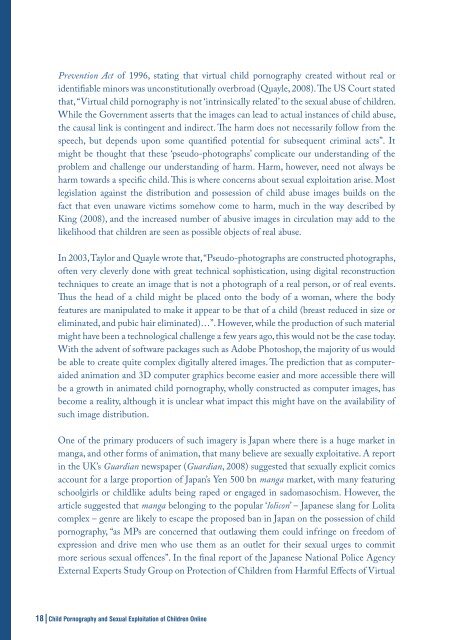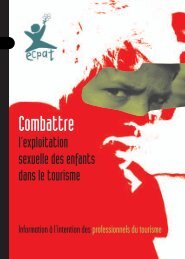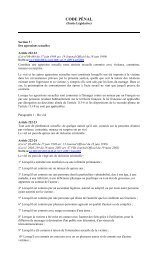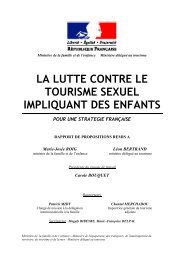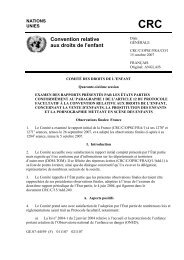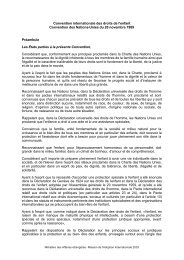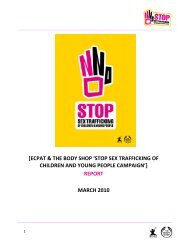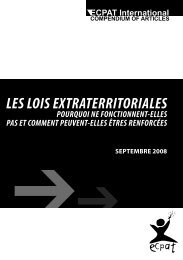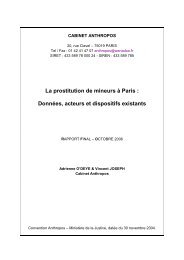child pornography and sexual exploitation of children online
child pornography and sexual exploitation of children online
child pornography and sexual exploitation of children online
Create successful ePaper yourself
Turn your PDF publications into a flip-book with our unique Google optimized e-Paper software.
Prevention Act <strong>of</strong> 1996, stating that virtual <strong>child</strong> <strong>pornography</strong> created without real or<br />
identifiable minors was unconstitutionally overbroad (Quayle, 2008). The US Court stated<br />
that, “Virtual <strong>child</strong> <strong>pornography</strong> is not ‘intrinsically related’ to the <strong>sexual</strong> abuse <strong>of</strong> <strong>child</strong>ren.<br />
While the Government asserts that the images can lead to actual instances <strong>of</strong> <strong>child</strong> abuse,<br />
the causal link is contingent <strong>and</strong> indirect. The harm does not necessarily follow from the<br />
speech, but depends upon some quantified potential for subsequent criminal acts”. It<br />
might be thought that these ‘pseudo-photographs’ complicate our underst<strong>and</strong>ing <strong>of</strong> the<br />
problem <strong>and</strong> challenge our underst<strong>and</strong>ing <strong>of</strong> harm. Harm, however, need not always be<br />
harm towards a specific <strong>child</strong>. This is where concerns about <strong>sexual</strong> <strong>exploitation</strong> arise. Most<br />
legislation against the distribution <strong>and</strong> possession <strong>of</strong> <strong>child</strong> abuse images builds on the<br />
fact that even unaware victims somehow come to harm, much in the way described by<br />
King (2008), <strong>and</strong> the increased number <strong>of</strong> abusive images in circulation may add to the<br />
likelihood that <strong>child</strong>ren are seen as possible objects <strong>of</strong> real abuse.<br />
In 2003, Taylor <strong>and</strong> Quayle wrote that, “Pseudo-photographs are constructed photographs,<br />
<strong>of</strong>ten very cleverly done with great technical sophistication, using digital reconstruction<br />
techniques to create an image that is not a photograph <strong>of</strong> a real person, or <strong>of</strong> real events.<br />
Thus the head <strong>of</strong> a <strong>child</strong> might be placed onto the body <strong>of</strong> a woman, where the body<br />
features are manipulated to make it appear to be that <strong>of</strong> a <strong>child</strong> (breast reduced in size or<br />
eliminated, <strong>and</strong> pubic hair eliminated)…”. However, while the production <strong>of</strong> such material<br />
might have been a technological challenge a few years ago, this would not be the case today.<br />
With the advent <strong>of</strong> s<strong>of</strong>tware packages such as Adobe Photoshop, the majority <strong>of</strong> us would<br />
be able to create quite complex digitally altered images. The prediction that as computeraided<br />
animation <strong>and</strong> 3D computer graphics become easier <strong>and</strong> more accessible there will<br />
be a growth in animated <strong>child</strong> <strong>pornography</strong>, wholly constructed as computer images, has<br />
become a reality, although it is unclear what impact this might have on the availability <strong>of</strong><br />
such image distribution.<br />
One <strong>of</strong> the primary producers <strong>of</strong> such imagery is Japan where there is a huge market in<br />
manga, <strong>and</strong> other forms <strong>of</strong> animation, that many believe are <strong>sexual</strong>ly exploitative. A report<br />
in the UK’s Guardian newspaper (Guardian, 2008) suggested that <strong>sexual</strong>ly explicit comics<br />
account for a large proportion <strong>of</strong> Japan’s Yen 500 bn manga market, with many featuring<br />
schoolgirls or <strong>child</strong>like adults being raped or engaged in sadomasochism. However, the<br />
article suggested that manga belonging to the popular ‘lolicon’ – Japanese slang for Lolita<br />
complex – genre are likely to escape the proposed ban in Japan on the possession <strong>of</strong> <strong>child</strong><br />
<strong>pornography</strong>, “as MPs are concerned that outlawing them could infringe on freedom <strong>of</strong><br />
expression <strong>and</strong> drive men who use them as an outlet for their <strong>sexual</strong> urges to commit<br />
more serious <strong>sexual</strong> <strong>of</strong>fences”. In the final report <strong>of</strong> the Japanese National Police Agency<br />
External Experts Study Group on Protection <strong>of</strong> Children from Harmful Effects <strong>of</strong> Virtual<br />
18|Child Pornography <strong>and</strong> Sexual Exploitation <strong>of</strong> Children Online


